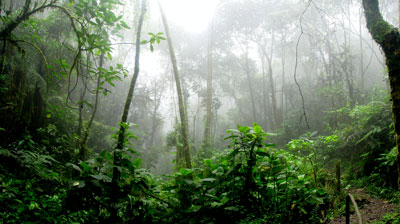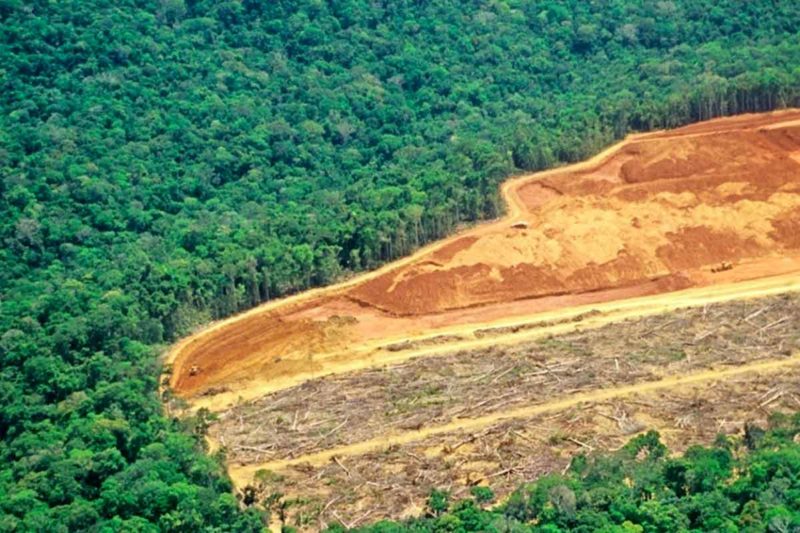The fashion industry is not the first thing that comes to mind when the deforestation of the Amazon rainforest is mentioned. Instead, we think of Jair Bolsonaro’s diatribes and forest fires being used to clear the way for more palm or soya crops. Yet a study by Stand.earth published in December 2021 establishes an indirect link that has been shown to have major impact.
Deforestation caused by cattle farming in the Amazon rainforest accounts for 2% of annual global CO2 emissions, which is on a par with total air travel emissions!
After reading this you won’t see your ankle boots or handbag the same way.
The planet’s green lung has become a source of CO2 emissions

What with forest fires and intensive farming, the world’s largest tropical forest has been shrinking drastically in recent years. According to data provided by the PRODES deforestation monitoring system at the Brazilian national institute for space research (INPE), logging in the world’s largest tropical forest spanned 13,235 km2 during the period 2020-2021. Since President Bolsonaro came to power in 2019, partly thanks to support from the powerful agribusiness lobby, average annual deforestation has exceeded 10,000 km2: a surface area as big as Lebanon. This compares to around 6,500 km2 during the previous decade. A study published in April 2021 in Nature Climate Change showed that, between 2010 and 2019, the Amazon rain forest emitted around 18% more carbon dioxide than it absorbed. That equates to 4.45 billion tonnes emitted, versus 3.78 billion tonnes locked away. Experts state that the deforestation of the Amazon rainforest is close to reaching its “tipping point”, and over time it could lead to “dramatic and irreversible” disruption to the climate.
Cattle farming – the top cause of deforestation in the Amazon rainforest
It’s a little-known fact that much of the leather of which our shoes, bags and other leather goods are made is thought to come from cows farmed in the Amazon rainforest. And this cattle farming is in fact the top cause of deforestation in the Amazon rainforest, due to the thousands of trees felled to turn these areas into grazing pastures. Contrary to popular belief, in this respect the cattle farming industry is way ahead of the palm oil, soya and cocoa industries. This makes it the top cause of deforestation in the Amazon rainforest, as determined in a report by the World Resources Institute. 36% of the 45 million hectares of forest destroyed between 2001 and 2015 was cleared to make way for cattle ranches.
Brazil – the world’s top cow hide exporter


Brazil has the world’s biggest cattle headcount, at 215 million animals. Besides meat, this cattle provides vast amounts of leather, which flood the global markets, since 80% of Brazil’s leather production gets exported. It goes mainly to China (41.6%), Italy (27.3%) and Vietnam (9.6%), followed by many more countries. The Brazilian leather industry yielded USD 1.1 bn in 2020, for the main producers JBS – in the lead by a long way – followed by Minerva and Fuga Couros. To meet consumer demand for leather wallets, handbags and shoes the industry will have to slaughter 430 million cows per year between now and 2025, as stated in an article in The Guardian.
De nombreuses grandes marques auraient des A great many big brands are thought to have direct or indirect links with these hide suppliers
Stand.earth analysed millions of data points from public-sector organisations and customs authorities. The analysis showed a significant lack of transparency across the supply chain (deforestation, slaughter, leather tanning and item production). Ultimately, a great many links have been forged between suppliers, brands and Brazil’s six main leather exporters.
To focus only on Brazil’s biggest leather exporter JBS – which is known for its impact in terms of deforestation in the Amazon rainforest, and known to engage in illegal practices – it alone is thought to have links to some 50 brands. While the study does not demonstrate that there is a direct link between each brand and deforestation in the Amazon rainforest, researchers nonetheless found multiple connections in the fashion industry‘s global supply chains. These links do not constitute absolute proof, but show that brands are highly likely to use hides produced via deforestation.
In total, this is thought to apply to some 100 brands. Among them are big names in sportswear (Reebok-Adidas, Puma, New Balance, Nike, Converse, Vans, Dr Martens, Camper and Caterpillar), fast fashion brands (Zara, H&M, Gap and Marks & Spencer) and high-end labels like Coach, Ralph Lauren, Chloé, Lacoste, Fendi (LVMH), DKNY and Michael Kors.
Certification does not mean that leather is not produced via deforestation

Two thirds of the companies to which this potentially applies have no CSR policy commitments on the sourcing of leather produced via deforestation. The others (22 out of 74) have made commitments, yet are liable to breach them, sometimes unbeknownst to them, via middlemen and suppliers. Some are even members of the Leather Working Group (LWG), which has pledged to make commitments on leather from deforestation shortly. At present it only assesses tanneries’ ability to trace leather back to the abattoir, and not right back to the ranch. Thus LWG certification does not at present vouch for leather not having been produced via deforestation.
As surprising as it may be, our shoes are implicated in the deforestation of what was once the planet’s green lung. So even if you don’t plan on going vegan or dropping leather, it’s time to insist that your favourite brands put more effort into the sourcing of their hides.







